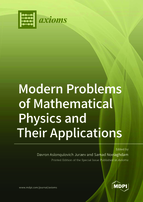Modern Problems of Mathematical Physics and Their Applications
A special issue of Axioms (ISSN 2075-1680). This special issue belongs to the section "Mathematical Physics".
Deadline for manuscript submissions: closed (30 September 2021) | Viewed by 58825
Special Issue Editors
Interests: differential equations; equations of mathematical physics; partial differential equations; solving ill-posed problems; Cauchy problem for first order elliptic systems; solving integral equations; Cauchy problem for elliptic equations; approximate solutions of the Cauchy problem for elliptic systems and equations
2. Department of Applied Mathematics and Programming, South Ural State University, Lenin Prospect 76, 454080 Chelyabinsk, Russia
Interests: numerical analysis; solving integral equations; solving ODEs and PDEs; solving ill-posed problems; fuzzy mathematics; stochastic arithmetic; CADNA library; CESTAC method; solving biomathematical models; iterative methods; numerical methods
Special Issues, Collections and Topics in MDPI journals
Special Issue Information
Dear Colleagues,
We invite you to submit your research papers in the field of modern mathematical physics problems to this Special Issue, entitled “Modern Problems of Mathematical Physics and Their Applications”, of the journal Axioms. We seek studies on new and innovative approaches to solving mathematical physics problems in linear and nonlinear forms. We also aim to cover high-dimensional problems and systems of equations. We welcome submissions presenting new theoretical results, structural investigations, new models and algorithmic approaches, and new applications of mathematical physics problems.
Prof. Dr. Davron Aslonqulovich Juraev
Prof. Dr. Samad Noeiaghdam
Guest Editors
Manuscript Submission Information
Manuscripts should be submitted online at www.mdpi.com by registering and logging in to this website. Once you are registered, click here to go to the submission form. Manuscripts can be submitted until the deadline. All submissions that pass pre-check are peer-reviewed. Accepted papers will be published continuously in the journal (as soon as accepted) and will be listed together on the special issue website. Research articles, review articles as well as short communications are invited. For planned papers, a title and short abstract (about 100 words) can be sent to the Editorial Office for announcement on this website.
Submitted manuscripts should not have been published previously, nor be under consideration for publication elsewhere (except conference proceedings papers). All manuscripts are thoroughly refereed through a single-blind peer-review process. A guide for authors and other relevant information for submission of manuscripts is available on the Instructions for Authors page. Axioms is an international peer-reviewed open access monthly journal published by MDPI.
Please visit the Instructions for Authors page before submitting a manuscript. The Article Processing Charge (APC) for publication in this open access journal is 2400 CHF (Swiss Francs). Submitted papers should be well formatted and use good English. Authors may use MDPI's English editing service prior to publication or during author revisions.
Keywords
- integral equations
- ill-posed problems
- ordinary differential equations
- partial differential equations
- system of equations
- fractional problems
- linear and nonlinear problems
- fuzzy problems
- numerical methods
- analytical methods
- semianalytical methods
- convergence analysis
- error analysis
- mathematical models
Benefits of Publishing in a Special Issue
- Ease of navigation: Grouping papers by topic helps scholars navigate broad scope journals more efficiently.
- Greater discoverability: Special Issues support the reach and impact of scientific research. Articles in Special Issues are more discoverable and cited more frequently.
- Expansion of research network: Special Issues facilitate connections among authors, fostering scientific collaborations.
- External promotion: Articles in Special Issues are often promoted through the journal's social media, increasing their visibility.
- e-Book format: Special Issues with more than 10 articles can be published as dedicated e-books, ensuring wide and rapid dissemination.
Further information on MDPI's Special Issue polices can be found here.






